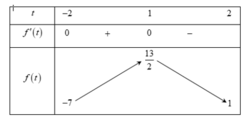Cho đa thức bậc hai M(x) thỏa mãn điều kiện M(-1)=M(1).
CMR:M(x)=M(-x) với mọi giá trị của x.
Hãy nhập câu hỏi của bạn vào đây, nếu là tài khoản VIP, bạn sẽ được ưu tiên trả lời.


\(\Delta'=\left(m-1\right)^2+m^3-\left(m+1\right)^2=m^3-4m\ge0\) \(\Rightarrow\left[{}\begin{matrix}m\ge2\\-2\le m\le0\end{matrix}\right.\)
Theo hệ thức Viet: \(\left\{{}\begin{matrix}x_1+x_2=2\left(m-1\right)\\x_1x_2=-m^3+\left(m+1\right)^2\end{matrix}\right.\)
Do \(x_1+x_2\le4\Rightarrow m-1\le2\Rightarrow m\le3\)
\(\Rightarrow\left[{}\begin{matrix}2\le m\le3\\-2\le m\le0\end{matrix}\right.\)
\(P=x_1^3+x_2^3+3x_1x_2\left(x_1+x_2\right)+8x_1x_2\)
\(=\left(x_1+x_2\right)^3+8x_1x_2\)
\(=8\left(m-1\right)^3+8\left[-m^3+\left(m+1\right)^2\right]\)
\(=8\left(5m-2m^2\right)\)
\(P=8\left(5m-2m^2-2+2\right)=16-8\left(m-2\right)\left(2m-1\right)\le16\)
\(P_{max}=16\) khi \(m=2\)
\(P=8\left(5m-2m^2+18-18\right)=8\left(9-2m\right)\left(m+2\right)-144\ge-144\)
\(P_{min}=-144\) khi \(m=-2\)

\(\Delta=\left(4m+1\right)^2-8\left(m-4\right)=16m^2+33>0;\forall m\)
Pt luôn có 2 nghiệm pb với mọi m
Theo hệ thức Viet: \(\left\{{}\begin{matrix}x_1+x_2=-4m-1\\x_1x_2=2m-8\end{matrix}\right.\)
a. Kết hợp hệ thức Viet và đề bài: \(\left\{{}\begin{matrix}x_1+x_2=-4m-1\\x_2-x_1=17\end{matrix}\right.\)
\(\Leftrightarrow\left\{{}\begin{matrix}x_1=-2m-9\\x_2=-2m+8\end{matrix}\right.\)
Thế vào \(x_1x_2=2m-8\)
\(\Rightarrow\left(-2m-9\right)\left(-2m+8\right)=2m-8\)
\(\Leftrightarrow m^2-9m+20=0\Rightarrow\left[{}\begin{matrix}m=4\\m=5\end{matrix}\right.\)
b.
\(A=\left(x_1-x_2\right)^2=\left(x_1+x_2\right)^2-4x_1x_2\)
\(A=\left(4m+1\right)^2-8\left(m-4\right)\)
\(A=16m^2+33\ge33\)
\(A_{min}=33\) khi \(m=0\)
c.
Theo hệ thức Viet: \(\left\{{}\begin{matrix}x_1+x_2=-4m-1\\x_1x_2=2m-8\end{matrix}\right.\)
\(\Leftrightarrow\left\{{}\begin{matrix}x_1+x_2=-4m-1\\2x_1x_2=4m-16\end{matrix}\right.\)
Cộng vế với vế:
\(x_1+x_2+2x_1x_2=-17\)
Đây là hệ thức liên hệ 2 nghiệm ko phụ thuộc m

a, \(\Delta=m^2-4\left(-4\right)=m^2+16\)> 0
Vậy pt luôn có 2 nghiệm pb
b, Theo Vi et \(\left\{{}\begin{matrix}x_1+x_2=m\\x_1x_2=-4\end{matrix}\right.\)
Ta có \(\left(x_1+x_2\right)^2-2x_1x_2=5\)
Thay vào ta được \(m^2-2\left(-4\right)=5\Leftrightarrow m^2+3=0\left(voli\right)\)
Bạn ơi, mình có thể hỏi câu c được không ạ? Nếu không được thì không sao, mình cảm ơn câu trả lời của bạn ạ ^-^ chúc bạn một ngày tốt lành nhé.

a) ĐKXĐ: \(x\notin\left\{-3;2\right\}\)
b) Ta có: \(P=\dfrac{x^3+2x^2-5x-6}{x^2+x-6}\)
\(=\dfrac{x^3+3x^2-x^2-3x-2x-6}{\left(x+3\right)\left(x-2\right)}\)
\(=\dfrac{x^2\left(x+3\right)-x\left(x+3\right)-2\left(x+3\right)}{\left(x+3\right)\left(x-2\right)}\)
\(=\dfrac{\left(x+3\right)\left(x^2-x-2\right)}{\left(x+3\right)\left(x-2\right)}\)
\(=\dfrac{\left(x-2\right)\left(x+1\right)}{x-2}=x+1\)
Với mọi x nguyên thỏa ĐKXĐ, ta luôn có: x+1 là số nguyên
hay P là số nguyên(đpcm)

Chọn B.
P =
2
(
x
3
+
y
3
)
-
3
x
y
![]()
![]() (do
x
2
+
y
2
=
2
)
(do
x
2
+
y
2
=
2
)
Đặt x + y = t. Ta có
x
2
+
y
2
=
2

Từ ![]()

P = f(t) 

Xét f(t) trên [-2;2].
Ta có ![]()

Bảng biến thiên

Từ bảng biến thiên ta có max P = max f(t) = 13 2 ; min P = min f(t) = -7
Lời bình: Có thể thay bbt thay bằng
Ta có ![]()

Suy ra kết luận.
M(x) = ax2 + bx + c
Vì M(-1) = M(1)
=> a + b + c = a - b + c
=> b = -b
=> b + b = 0
=> b = 0
=> M(x) = ax2 + c
Ta có: M(-x) = a(-x)2 + c = ax2 + c
Vậy M(x) = M(-x)